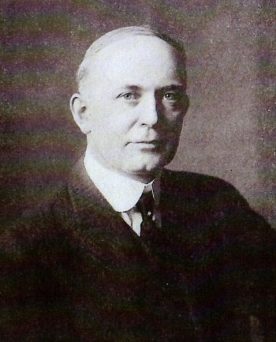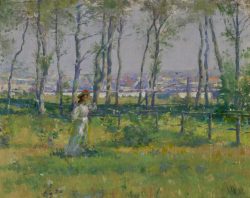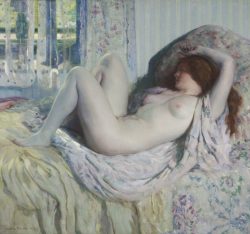Lawton Parker, from a photograph reproduced in Lena M. McCauley, “Lawton S. Parker,” The Art Student 1 (Oct. 1915).

Lawton Parker 1868–1954
A farm-boy from Kearney, Nebraska, Lawton Silas Parker began his training at the Art Institute of Chicago as a teenager. In 1888, he went to Paris, where he met the stringent entrance requirements for the prestigious École des Beaux-Arts; he later transferred to the Académie Julian, a favorite among American art students. One of Parker’s paintings was juried into the Paris Salon exhibition of 1890. In the following decade, he led a peripatetic life that included further study at the Art Students League in New York City and in Paris; teachings stints in St. Louis, Chicago, New York, Paris, and Beloit, Wisconsin; and work on commissioned portraits and a mural. He won several scholarships and awards, including honors for his entries in the Paris Salon exhibitions of 1900 and 1902.
Parker was associated with Chicago for several years beginning around 1901, when he briefly held a faculty appointment at the Art Institute. In addition to showing his work in the museum’s annual exhibitions of American art, he participated in several of its salons for Chicago artists between 1904 and 1916. In 1908 he received the Chicago Society of Artists’ gold medal. He painted portraits of numerous important Chicagoans. Maintaining a studio-residence in Chicago, he exhibited at national and international venues, garnering several major prizes.
Around 1909, Parker joined the seasonal art colony in Giverny, France, which he may have first visited as early as 1903. There, working closely with Frederick Frieseke and other American artists, he fully embraced impressionism in his richly colored images of women posed outdoors on sun-dappled riverbanks or in the enclosed garden he shared with Frieseke. Parker was represented in the exhibition of the “Giverny Group” at New York’s Madison Art Gallery in 1910, and two years later the Art Institute hosted a solo exhibition of his luminous paintings. While critically successful, Parker’s nudes aroused controversy in the contemporary art exhibitions hosted by conservative museums such as the Art Institute, prompting the artist to relocate his American studio to New York around 1916. That year he was elected an associate member of the National Academy of Design. In New York, Parker was instrumental in the construction of the Rodin Studio Building for artists, designed by architect Cass Gilbert.
Parker spent much of the following quarter-century in France, leaving in 1942 only when forced to do so by the German occupation and abandoning many of his canvases. He settled with his family in Pasadena, California, and was the subject of an exhibition at the Pasadena Art Institute in 1945. For the remainder of his life, Parker worked in relative obscurity, his colorful impressionist style eclipsed by more up-to-date artistic approaches.
Wendy Greenhouse, PhD

